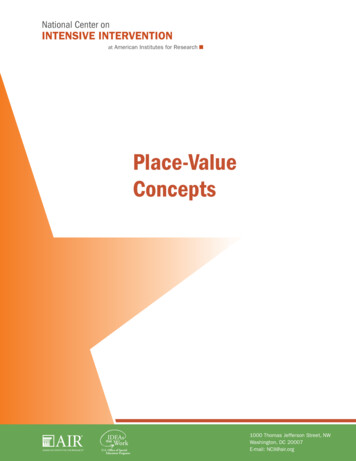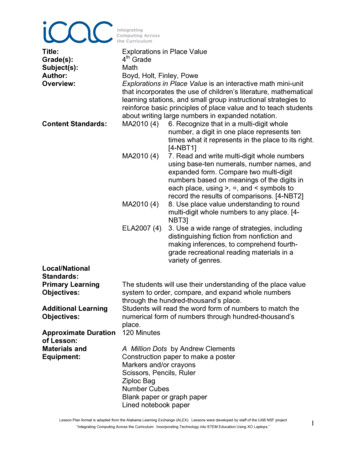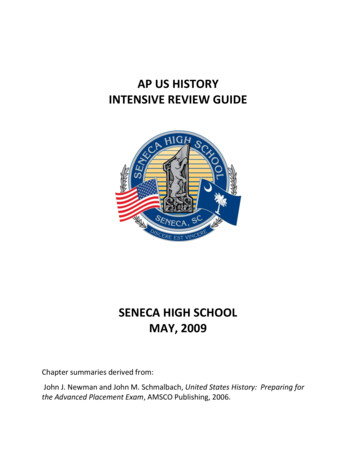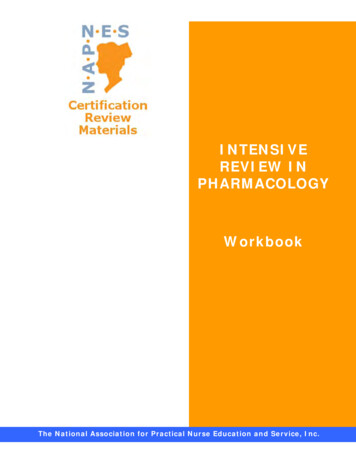
Transcription
National Center onINTENSIVE INTERVENTIONat American Institutes for ResearchPlace-ValueConcepts1000 Thomas Jefferson Street, NWWashington, DC 20007E-mail: NCII@air.org
While permission to reprint this publication is not necessary, the citation should be:National Center on Intensive Intervention. (2015). Place-value concepts. Washington, DC: U.S. Department ofEducation, Office of Special Education Programs, National Center on Intensive Intervention.This document was produced under the U.S. Department of Education, Office of Special Education Programs,Award No. H326Q110005. Celia Rosenquist serves as the project officer. The views expressed herein do notnecessarily represent the positions or polices of the U.S. Department of Education. No official endorsementby the U.S. Department of Education of any product, commodity, service or enterprise mentioned in thiswebsite is intended or should be inferred.
Contents1.Teaching Place-Value Concepts: Considerations for Instruction . . . . . . . . 12.Understanding Place Value: Representing Tens and Ones . . . . . . . . . . 8Activity One: Representing Tens and Ones. . . . . . . . . . . . . . . . . . . . 9Worksheets . . . . . . . . . . . . . . . . . . . . . . . . . . . . . . . . . . 12a. Understanding Place Value: Representing Tens and Ones . . . . . . . . . . . 12b. Understanding Place Value: Representing Tens and Ones—Scaffolded . . . 143.Understanding Place Value: Using Base-10 Blocks. . . . . . . . . . . . . 17Activity One: Using Base-10 Blocks . . . . . . . . . . . . . . . . . . . . . . . 18Worksheets . . . . . . . . . . . . . . . . . . . . . . . . . . . . . . . . . .23a. Understanding Place Value: Using Base-10 Blocks . . . . . . . . . . . . . . 23b. Understanding Place Value: Using Base-10 Blocks—Scaffolded . . . . . . . . 264.Understanding Place Value: Comparing Two-Digit Numbers. . . . . . . . . 29Activity One: Representing Tens and Ones. . . . . . . . . . . . . . . . . . . . 30Worksheet . . . . . . . . . . . . . . . . . . . . . . . . . . . . . . . . . . .35a. Understanding Place Value: Comparing Two-Digit Numbers . . . . . . . . . . 355.Supplemental Materials. . . . . . . . . . . . . . . . . . . . . . . . . . . . 38a. Number Line 0-10 . . . . . . . . . . . . . . . . . . . . . . . . . . . . . .39b. Number Line 0-20 . . . . . . . . . . . . . . . . . . . . . . . . . . . . . .40c. Base-10 Blocks . . . . . . . . . . . . . . . . . . . . . . . . . . . . . . .411000 Thomas Jefferson Street, NWWashington, DC 20007E-mail: NCII@air.org
d. Place-Value Mat: Hundreds, Tens, Ones . . . . . . . . . . . . . . . . . . . 43e. Place-Value Mat: Tens, Ones . . . . . . . . . . . . . . . . . . . . . . . . . 444430ab 11/15f. Two-Digit Number Flashcards . . . . . . . . . . . . . . . . . . . . . . . . 45ivIntensive Instruction: Place-Value Concepts
Teaching Place-Value Concepts:Considerations for InstructionPurpose and Overview of GuideThe purpose of this guide is to provide strategies and materials for developing andimplementing lessons for students who need intensive instruction in place value. Specialeducation teachers, mathematics interventionists, and others working with studentsstruggling with place-value concepts may find this guide helpful.Within college- and career-ready standards, place value is typically taught in grades K–5.This guide can be used when place-value concepts are introduced or with students inhigher grade levels who continue to struggle with the concepts. Sample activities,worksheets and supplemental materials also accompany the guide and are available fordownload at http://www.intensiveintervention.org/.The guide is divided into four sections:1. Sequence of skills as defined by the college- and career-ready standards2. A list of important vocabulary and symbols3. A brief explanation of the difficulties students may have with place value4. Suggested strategies for teaching place-value conceptsSequence of Skills – College- and Career-Ready Standards(Numbers in parentheses represents the grade level of the standard.)EXTEND THE COUNTING SEQUENCE. Count to 120, starting at any number. (1) Read and write numerals. (1) Count within 1,000. (2) Skip-count by 5s, 10s, and 100s. (2)UNDERSTAND PLACE VALUE. Compose and decompose numbers from 11 to 19 into tens and ones. (K) Understand a two-digit number as represented by amounts of tens and ones. (1) Understand 10 can be thought of as a bundle of 10 ones—called a “ten.” (1)1000 Thomas Jefferson Street, NWWashington, DC 20007E-mail: NCII@air.org
a three-digit number as represented by amounts of hundreds, tens, Understandand ones. (2) Read and write numbers to 1,000. (2) Compare two three-digit numbers. (2) Round whole numbers to the nearest 10 or 100. (3)that in a multidigit whole number, a digit in one place represents 10 times Recognizewhat it represents in the place to its right. (4) Read and write multidigit whole numbers. (4) Compare two multidigit numbers. (4) Round multidigit whole numbers to any place. (4)that in a multidigit number, a digit in one place represents 10 times as Recognizemuch as it represents in the place to its right and 1/10 of what it represents in theplace to its left. (5)patterns in the number of zeros of the product when multiplying a number Explainby powers of 10. (5)patterns in the placement of the decimal point when a decimal is multiplied Explainor divided by a power of 10. (5) Use whole-number exponents to denote powers of 10. (5) Read, write, and compare decimals to thousandths. (5) Compare two decimals to thousandths. (5) Round decimals to any place. (5)Vocabulary and SymbolsThe following terms are important for students to understand when working with place value.Digit: A symbol used to show anumber0, 1, 2, 3, 4, 5, 6, 7, 8, 9Place Value: The quantityrepresented by the position of adigit relative to the decimal42,103. 2 is in the thousandsplace, so its place value is 2000.2Value: Quantity of a digit2 2 ones39 3 tens and 9 onesPlace: The position of a digitrelative to the decimalOnes, tens, hundreds, etc.Standard notation: Writing anumber with one digit in eachplace valueExpanded notation: Writing anumber and showing the placevalue of each digit42,10340,000 2,000 100 3Place-Value Concepts: Considerations for Instruction
Word form: Writing a numberusing wordsDecimal: A number written on thebasis of powers of tenForty-two thousand, one-hundredthree.Zero: A digit representing theabsence of quantity. Zero isnecessary in holding place value.53.10953.109Estimate: An approximate value402,005Regroup: Exchange equalamounts of tens and ones,hundreds and tens, thousandsand hundreds, etc.Decimal point: A dot noting thechange from positive powers often (left of point) to negativepowers of ten (right of point)Round: Substitute an approxi mate value (usually to thenearest 10, 100, 1,000, etc.)Trade/exchange/borrow/carry/rename: Alternative terms forregrouping10 ones 1 ten1,000 10 hundredsCommon Areas of DifficultyPrerequisite skills not mastered: Knowledge or understanding of numbersSpecific Place-Value skills:(0) ZeroFor example, 602 is not the same as 62numbers ReadingFor example, two thousand, seventy-nine. NOT two thousand and seventy and nine.place value UnderstandingFor example, in the number 312, the 1 represents 1 ten, not 1 one.Developing Conceptual UnderstandingBase-10 blocks can be used to help students understand the concepts behind placevalue. Base-10 blocks also can be used to explain decimals. Other place-valuemanipulatives are Unifix cubes, snap cubes, plastic clips, and bean sticks/beans.Place-Value Concepts: Considerations for Instruction3
Activities and Strategies Related to Specific StandardsCount to 120, starting at any number. (1)Count within 1,000. (2) Practice with counting objects, on number lines, or on hundreds charts. Count the number of school days.Hundreds p-count by 5s, 10s, and 100s. (2) Practice with counting sets of objects, on number lines, or on hundreds charts. Sing counting songs. (Many examples are provided on YouTube.)Read and write numerals. (1)Read and write numbers to 1,000. (2)Read and write multidigit whole numbers. (4) Practice handwriting for writing numerals.§ Check for appropriate pencil grip.§ Use poems to remember how to write numerals.§ Explicitly teach students how to write numbers, and practice correct procedure. Write an orally presented number.§ Present numbers of increasing difficulty. Break 23 into tens and ones.§ 23 2 tens, 3 ones Represent 2 tens and 3 ones as a number.§ 2 tens, 3 ones 23§ How many tens in 23?§ How many ones in 23?4Place-Value Concepts: Considerations for Instruction
Explain what each digit represents.§ 972 9 hundreds, 7 tens, and 2 ones.Compose and decompose numbers from 11 to 19 into tens and ones. (K)Understand a two-digit number as represented by amounts of tens and ones. (1)Understand 10 can be thought of as a bundle of 10 ones—called a “ten.” (1) Show 17 in base-10 units. How many sets of ten? How many remaining ones? Line up 10 base-10 units and show equivalency to one rod. Line up one base-10 rod and show equivalency to 10 units. Represent 45 with base-10 blocks. How many sets of ten? How many remaining ones?hands to show 45. Flash four bundles of 10 (“10, 20, 30, 40”). Hold up one Usefinger for each one (“41, 42, 43, 44, 45”). Draw circles around sets of 10 presented on paper.Understand a three-digit number as represented by amounts of hundreds, tens, andones. (2) Line up 10 base-10 rods and show equivalency to 1 flat.up one base-10 flat and show equivalency to 10 rods. Show equivalency to Line100 ones.124 with base-10 blocks. How many sets of hundred? How many sets Representof ten? How many remaining ones? Draw a three-digit number with squares, lines, and little squares.Place-Value Concepts: Considerations for Instruction5
Compare two three-digit numbers. (2)Compare two multidigit numbers. (4)Read, write, and compare decimals to thousandths. (5) Teach and signs with a Greater Gator. Teach sign with an understanding of making two sides of an equation the same. Use base-10 blocks to show two numbers. Compare.§ Which amount is greater?§ Which amount is smaller?§ Are the amounts the same? Show two numbers in standard form. Show two numbers in expanded form. Show two numbers in word form.§ Which amount is greater?§ Which amount is less?§ Which amount is bigger?§ Which amount is smaller?§ Are the amounts the same?Recognize that in a multidigit whole number, a digit in one place represents 10 timeswhat it represents in the place to its right. (4)Recognize that in a multidigit number, a digit in one place represents 10 times asmuch as it represents in the place to its right and 1/10 of what it represents inthe place to its left. (5)Explain patterns in the number of zeros of the product when multiplying a numberby powers of 10. (5)6Place-Value Concepts: Considerations for Instruction
Explain patterns in the placement of the decimal point when a decimal is multipliedor divided by a power of 10. (5)Use whole-number exponents to denote powers of 10. (5) Discuss 1 cube 10 flats 100 rods 1,000 units. For decimals, discuss 1 flat 10 rods (tenths) 100 units (hundredths) Explain decimal point.§ Discuss implicitness of decimal point for all whole numbers.has a decimal point after the 5, but we don’t write it that way. We write the 425decimal point only if there are numbers to the right of the decimal point.the decimal point as “and.” 425.38 reads as “four-hundred twenty-five and Readthirty-eight hundredths.” Show the following pattern:§ 1 x 10 10§ 10 x 10 100§ 100 x 10 1,000§ 1,000 x 10 10,000§ 10,000 x 10 100,000§ 0.1 x 10 1§ 0.01 x 10 0.1§ 0.001 x 10 0.01 Explain exponents.§ 100 1§ 101 10§ 102 100§ 103 1,000§ 104 10,000§ 10-1 0.1§ 10-2 0.01§ 10-3 0.001Round whole numbers to the nearest 10 or 100. (3)Round multidigit whole numbers to any place. (4)§ Teach students to underline the place value of desired rounding. If the digit tothe right of underlined digit is 0–4, round down. If 5–9, round up.§ Round to the nearest ten thousand. 546,388. 550,000.Place-Value Concepts: Considerations for Instruction74430c 11/15Round decimals to any place. (5)
2. Place-Value Concepts:Understanding Place Value:Representing Tens and OnesSample Activitiesa. Representing Tens and OnesWorksheetsa. Worksheet: Understanding Place Value: Representing Tens and Onesb. Worksheet: Understanding Place Value: Representing Tens and Ones—Scaffolded1000 Thomas Jefferson Street, NWWashington, DC 20007E-mail: NCII@air.org
Understanding Place Value:Representing Tens and OnesCollege- and Career-Ready Standards Addressed:K.NBT.1: Compose and decompose numbers from 11 to 19 into 10 ones and somefurther ones. Record each composition or decomposition by a drawing or equation (e.g., 18 10 8).that these numbers are composed of 10 ones and one, two, three, four, Understandfive, six, seven, eight, or nine ones.1.NBT.2: Understand that the two digits of a two-digit number represent amounts of tensand ones. Understand the following as special cases: 10 can be thought of as a bundle of 10 ones—called a ten.numbers from 11 to 19 are composed of a ten and one, two, three, four, five, Thesix, seven, eight, or nine ones.numbers 10, 20, 30, 40, 50, 60, 70, 80, 90 refer to one, two, three, four, five, Thesix, seven, eight, or nine tens (and 0 ones).Activity One: Representing Tens and OnesPurpose: To represent one- and two-digit numbers using concrete manipulatives.Principles of Intensive Intervention Illustrated: Provide concrete learning opportunities (including use of manipulatives). Provide explicit error correction, and have students repeat the correct process. Use precise, simple language to teach key concepts or procedures.explicit instruction and modeling with repetition to teach a concept or Usedemonstrate steps in a process. Provide repeated opportunities to practice each step correctly.Materials: Bears (or other manipulative to use for counting) Cups Paper and pencil or dry-erase board Number line (see Supplemental Materials)Understanding Place Value: Representing Tens and Ones (for extra Worksheet:practice)Understanding Place Value: Representing Tens and Ones—Scaffolded Worksheet:(for extra practice)Place-Value Concepts: Considerations for Instruction9
Modeling:1. Write a two-digit number (e.g., 14). Show the two-digit number with bears. Say, “Thisis the number 14. Let’s count out 14 bears.”2. Introduce grouping into sets of 10. Count to 10 while holding up your fingers. Say,“In math, we group objects and numbers into sets of 10. Count to 10 with me: 1, 2,3, 4, 5, 6, 7, 8, 9, 10. How many fingers am I holding up? 10. That’s right. I have aset of 10 on my fingers. Can you show me a set of 10 with your fingers?”3. Group bears into sets of 10. Each set of 10 goes into a cup. Say, “Let’s see howmany sets of 10 are in the number 14. Let’s count out 10 bears and place them inthis cup. Ready? 1, 2, 3, 4, 5, 6, 7, 8, 9, 10. 10 bears go in a cup.”4. [Try to] Make another set of 10. Say, “Each set of 10 goes into a cup.”5. Discuss the inability to make any more sets of 10. Say, “We don’t have enoughbears to make another set of 10, so we’re finished making sets of 10.”6. Discuss how the sets of 10 and remaining ones are noted in the written numeral.Say, “How many sets of 10 did we make?” One. Say, “So, with 14 bears we haveone set of 10. I see the one set of 10 written here in the number 14.” Underlinethe 1 in 14. Say, “How many remaining ones do we have?” Four. Say, “So, with14 bears we have four remaining ones. I see the four remaining ones written herein the number 14.” Underline the 4 in 14.7. State that in a two-digit number, the left place is the tens and the right place is theones. Write the words “tens” and “ones” below 14.8. Repeat with two more examples (e.g., 23, 35).Guided Practice:1. Write a two-digit number (e.g., 27). Have the student show the number with bears.2. Have the student count out the sets of 10. The student places each set of 10 in adifferent cup.3. The student counts the sets of 10 and writes the number of tens.10Place-Value Concepts: Considerations for Instruction
4. The student counts the remaining ones and writes the number of ones.5. The student states number of tens and ones in the original number (e.g., “27 is twosets of 10 and seven ones”).6. Repeat with two more examples (e.g., 42, 12).7. Provide corrective feedback as necessary.Corrective Feedback:Example 1Student response: “27 has one ten.”Teacher feedback: 27 has 1 set of 10. That’s not quite right. Let’s check our work. Countwith me: 1, 2, 3, 4, 5, 6, 7, 8, 9, 10. Put that set of 10 in a cup. 27 has another set of10. Count with me: 1, 2, 3, 4, 5, 6, 7, 8, 9, 10. Put that set of 10 in a cup. Can I makeanother set of 10? Let me see: 1, 2, 3, 4, 5, 6, 7. No. I can’t make another set of 10.Only sets of 10 can go in a cup, so I leave these seven bears outside the cups. So, 27has 1, 2 cups. That’s two sets of 10. 27 has seven remaining ones. 27 has two tens andseven ones. How many tens and ones does 27 have?Example 2Student response: “27 has three tens.”Teacher feedback: That’s not quite right. Let’s check our work. Remember, each cup musthave 10 bears. We are making sets of 10. 27 has one set of 10. Count with me: 1, 2, 3,4, 5, 6, 7, 8, 9, 10. Put that set of 10 in a cup. 27 has another set of 10. Count with me:1, 2, 3, 4, 5, 6, 7, 8, 9, 10. Put that set of 10 in a cup. Can I make another set of 10? Ihave 1, 2, 3, 4, 5, 6, 7 remaining bears. Can seven bears go in a cup? No. Each cup musthave a set of 10 bears. 27 has 1, 2 cups. That’s two sets of 10. 27 has seven remainingones. 27 has two tens and seven ones. How many tens and ones does 27 have?Example 3Student response: Miscounts of ten.Teacher feedback: That’s not quite right. Let’s check our work. Let’s practice counting to10. Let’s put 10 bears in a row and count them. Let’s touch each bear as we give the beara count. Ready? 1, 2, 3, 4, 5, 6, 7, 8, 9, 10. Now, let’s count to 10 using a number line.Let’s touch each number as we count. Ready? 1, 2, 3, 4, 5, 6, 7, 8, 9, 10. Now, count to4430d 11/1510 using our fingers. Hold up one finger for each number you count. Ready? 1, 2, 3, 4, 5,6, 7, 8, 9, 10. Now let’s count to 10 three times. Ready?Place-Value Concepts: Considerations for Instruction11
WorksheetUnderstanding Place Value:Representing Tens and OnesObjective: Represent one- and two-digit numbers using manipulatives and tell howmany tens and ones are in a two-digit number.Directions: For each number, have students draw (with tallies, stars, circles) or usemanipulatives. Draw a circle around each group of ten, or otherwise mark to show agroup of ten. Then write how many tens and ones are in the number.NumberExample13181000 Thomas Jefferson Street, NWWashington, DC 20007E-mail: NCII@air.orgCountTensOnes13
NumberCountTensOnes11224430e 11/1517Place-Value Concepts: Considerations for Instruction13
WorksheetUnderstanding Place Value:Representing Tens and Ones—ScaffoldedObjective: Represent one- and two-digit numbers using representations and tell how manytens and ones are in a two-digit number.Directions: For each number, have students tally or shade in squares that represent onesin the box provided, while counting. The squares are organized in groups of tens. Use therepresentations to determine how many tens and ones are in the number.NumberExample13181000 Thomas Jefferson Street, NWWashington, DC 20007E-mail: NCII@air.orgCountTensOnes13
NumberCountTensOnes221726Place-Value Concepts: Considerations for Instruction15
NumberCountTensOnes35274430f 11/153116Place-Value Concepts: Considerations for Instruction
3. Place-Value Concepts:Understanding Place Value:Using Base-10 BlocksSample Activitiesa. Using Base-10 BlocksWorksheetsa. Worksheet: Understanding Place Value: Using Base-10 Blocksb. Worksheet: Understanding Place Value: Using Base-10 Blocks —Scaffolded1000 Thomas Jefferson Street, NWWashington, DC 20007E-mail: NCII@air.org
Understanding Place Value:Using Base-10 BlocksCollege- and Career-Ready Standard Addressed:2.NBT.1 Understand that the three digits of a three-digit number represent hundreds, tens,and ones. Understand the following as special cases: 100 can be thought of as a bundle of tens, or 10 tens, which is called a hundred.numbers 100, 200, 300, 400, 500, 600, 700, 800, and 900 refer to one, Thetwo, three, four, five, six, seven, eight, or nine hundreds (with 0 tens and 0 ones).Activity One: Using Base-10 BlocksPurpose: To represent three-digit numbers using proportional concrete manipulatives.Principles of Intensive Intervention Illustrated: Provide concrete learning opportunities (including use of manipulatives). Provide explicit error correction, and have students repeat the correct process. Use precise, simple language to teach key concepts or procedures.explicit instruction and modeling with repetition to teach a concept or Usedemonstrate steps in a process. Provide repeated opportunities to practice each step correctly.students can complete entire examples and explain their work, incorporate Oncefluency-building activities.Materials: Base-10 blocks (see Supplemental Materials)mat with columns for hundreds (flats), tens (rods), and ones (units— Place-valuesee Supplemental Materials) Paper and pencil or dry-erase board Worksheet: Understanding Place Value: Using Base-10 Blocks (for extra practice)Understanding Place Value: Using Base-10 Blocks—Scaffolded (for Worksheet:extra practice)18Place-Value Concepts: Considerations for Instruction
HundredsTensOnesModeling:1. Review a one-digit number with the student. Write the number and place thecorresponding number of units on a place-value mat. For example say, “This is thenumber 7. I can show the number 7 using my place-value mat. The number 7 has7 in the ones place. We use these little blocks, called units, to show the numberof ones. I count out 1, 2, , 7 units and place them in the ones column of themat. The number 7 does not have any tens or any hundreds, so we leave thosecolumns empty: 7 7 ones.”2. Review the number 10. Write the number 10. Place 10 units in the ones column.Line them up to show 10 units 1 rod. Exchange the 10 ones (units) for 1 ten (rod)and place in the tens column.3. Point to the 1 in the tens place of written number (10) and the 1 rod in the tenscolumn on the place-value mat. Emphasize that 0 in the ones place of a writtennumber corresponds to an empty ones column on the place-value mat. If necessary,repeat with two more two-digit numbers (e.g., 35 and 70).4. Write a three-digit number (e.g., 142). Place two units, four rods, and one flat intheir corresponding columns. Explain that the two units equal the number of ones inthe number 2, the four rods equal the number of tens in the number 4, and the oneflat equals the number of hundreds in the number 1. Draw a connection between thenumbers of objects in each column of the place-value mat the corresponding digits inthe written number.HundredsTensOnes 142Place-Value Concepts: Considerations for Instruction19
5. Provide two more examples (e.g., 623 and 551).6. Explain that hundreds are special numbers because they are bundles of tens, or 10tens (have students count out 10 tens to make 100). “The numbers 100, 200, ,900 refer to 1, 2, , 9 bundles of ten. They are different because they have 0 tensand 0 ones.” Write a three-digit number representing a multiple of 100 (e.g., 300).Use base-10 blocks to represent the number.HundredsTensOnes7. State that there are 0 ones, so the ones column is empty. Because there are 0tens, the tens column also is empty. There are 3 hundreds, and so there are threeflats in the hundreds column.8. Repeat with two more examples (e.g., 700 and 400).20Place-Value Concepts: Considerations for Instruction
Guided Practice:1. Write a three-digit number (e.g., 352); have the student represent it with base-10blocks on a place-value mat.2. Have the student state the number of ones, tens, and hundreds in the number.Ensure that it corresponds with the number of blocks on the place-value mat.Repeat with two more examples (e.g., 919 and 402).3. Write a three-digit multiple of 100 (e.g., 200); have the student represent it withbase-10 blocks.4. Have the student state the number of ones, tens, and hundreds in the number.Ensure that it corresponds with the number of blocks on the place-value mat.Repeat with two more examples (e.g., 700 and 900).5. Provide corrective feedback as necessary.Corrective Feedback:Example 1Student response: “402 forty-two”Teacher feedback: “This number is four hundred two. It has three digits (point and count):402 has 4 hundreds, 0 tens, and 2 ones. This number is forty-two. It has only two digits(point and count): 42 has 4 tens and 2 ones. The 0 in 402 is a placeholder and helps usremember that there are no tens in this number. Let’s use two place-value mats to showboth numbers so that we can see how they are different.”Example 2Student response: “200 has 20 tens and 0 ones. So I put 20 rods in the tens column ofmy place-value mat, and I leave the ones column empty.”Teacher feedback: “Remember, each column can have only up to 9. If we have 10 ofsomething, we must exchange. Remember, 10 ones 1 ten and 10 tens 1 hundred.I see that you put 20 rods to show 20 tens in your tens column. If we have a group of 10rods, we exchange them for a flat because 10 tens is 1 hundred. Let’s count by 10 to see:10, 20, , 100. So, we take these 10 rods out and exchange them for 1 flat. Where dowe put the flat? Good. It goes in the hundreds column. Do you think we have enough rodsin the tens column to exchange again? Show me. Good. Let’s look at the number again:200. How many hundreds are in 200? Yes, two. That’s why we have 2 flats in the hundredscolumn of our place-value mat. How many tens are in 200? How many ones?”Place-Value Concepts: Considerations for Instruction21
Example 3The student’s responses indicate that he or she has a conceptual understandingof basic place value but lacks fluency in recognizing the value of individual digits inmultidigit numbers.4430g 11/15Teacher feedback: Play Meet or Beat Your Score with place-value flashcards. Theflashcards should have one three-digit number printed on one side, with one of the digitsbolded (e.g., 348 with 4 bolded). The student reads the number aloud (e.g., “threehundred forty-eight”) and then identifies the place value associated with the bolded digitand assigns meaning to that value (e.g., “four stands for 4 tens or 40”). If the studentresponds correctly, place the card in a pile. If the student responds incorrectly, provideimmediate corrective feedback and have him or her repeat that card; then put it in thepile. The student has one minute to answer as many flashcards as possible, and thescore is noted. Then the student has one minute to try to meet or beat that score.22Place-Value Concepts: Considerations for Instruction
WorksheetUnderstanding Place Value:Using Base-10 BlocksObjective: Represent three-digit numbers as flats, rods, and units and tell how manyhundreds, tens, and ones are in a three-digit number. Count flats, rods, and units todetermine what three-digit number is being displayed.Directions: Use flats (hundreds), rods (tens), and units (ones) to build the number or drawa representation in the box. Write how many hundreds, tens, and ones are in each number.Example:Build or Draw the Number123HundredsTensOnes123Example:Build or Draw the Number219HundredsTens1000 Thomas Jefferson Street, NWWashington, DC 20007E-mail: NCII@air.orgOnes
Example:Build or Draw the Number495HundredsTensOnesBuild or Draw the NumberExample:572HundredsTensOnesBuild or Draw the NumberExample:314Hundreds24TensOnesPlace-Value Concepts: Considerations for Instruction
Example:Build or Draw the Number231HundredsTensOnesBuild or Draw the NumberExample:105TensOnes4430h 11/15HundredsPlace-Value Concepts: Considerations for Instruction25
WorksheetUnderstanding Place Value:Using Base-10 Blocks—ScaffoldedObjective: Represent three-digit numbers as flats, rods, and units and tell how manyhundreds, tens, and ones are in a three-digit number. Count flats, rods, and units todetermine what three-digit number is being displayed.Directions: Count and write the number of hundreds, tens, and ones. Then write thenumber that is represented by the blocks.HundredsTensOnesNumber1111111000 Thomas Jefferson Street, NWWashington, DC 20007E-mail: NCII@air.org
HundredsTensOnesPlace-Value Concepts: Considerations for InstructionNumber27
TensOnesNumber4430i 11/15Hundreds28Place-Value Concepts: Considerations for Instruction
4. Place-Value Concepts:Understanding Place Value:Comparing Two-Digit NumbersSample Activitiesa. Comparing Two-Digit NumbersWorksheetsa. Worksheet: Understanding Place Value: Comparing Two-Digit Numbers1000 Thomas Jefferson Street, NWWashington, DC 20007E-mail: NCII@air.org
Understanding Place Value:Comparing Two-Digit NumbersCollege- and Career-Ready Standards Addressed:1.NBT.B.2 Understand that the two digits of a two-digit number represent amounts of tensand ones. Understand the following as special cases: 10 can be thought of as a bundle of ten ones, or 10 tens, called a ten.numbers 10, 20, 30, 40, 50, 60, 70, 80, and 90 refer to one, two, three, four, Thefive, six, seven, eight, or nine tens (and 0 ones).1.NBT.B.3 Compare two-digit numbers based on meanings of the tens and ones digits,recording the results of comparisons with , , and symbols.Activity One: Representing Tens and OnesPurpose: To compare 2 digit numbers with and without the use of
Place-Value Concepts: Considerations for Instruction Understand a three-digit number a











